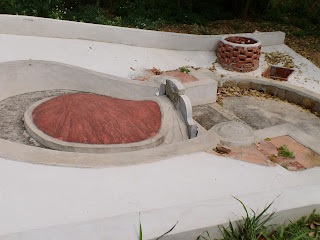金門の旅の続き:
翟山トンネルを出たら、次は近くに有るビーチに行って来た。この日は霧が凄かったので、ぽつんと立っているコンクリートは不思議な感じがしていた。
Continuing the second day of our trip, we left Zhaishan Tunnel and went to a nearby beach. Just because. It was very foggy that day (as it often is on Quemoy) so the atmosphere was pretty nice.
翟山坑道出走,再到旁邊的海邊去了。這天有很重的霧,所以氣氛很不可思議。
次、近くに有るサイクリングパースを使って歐厝と言う村に行った。
There was a bike path nearby that we decided to ride to Oucuo Village. If you look at the map below, you can see an area with a red line around it. There are still landmines buried in some areas of Quemoy.
後來用鐵馬道,到歐厝去。只要看到地圖就知道了,金門還有一點點地雷。地圖的被紅線包圍的地方就是有地雷的地方。
赤い線が敷いている場所は地雷がまだ埋まっている地域だ。
Amazingly enough, this bike path, which is advertised to tourists, goes right by some military training areas. It was pretty surreal to come around a bend in the path and see some soldiers in fatigues resting next to some machine guns on a shooting range. The shooting range was literally about 3 yards away from the bike path. I didn't take a picture because the soldiers and machine guns scared me, but when we passed by the entrance to another training ground (below) I took a photo.
雖然這條鐵馬路是觀光客用的,但是在旁邊有軍隊的基地!
このサイクリングパースは信じられない程基地の直ぐ隣りを通る。自転車に乗って、普通に機関銃の練習から休んでいる兵士達を通った。(射撃場は本当に自転車パースから2メートルも離れていない!)写真を撮るのはちょっと怖かったけど、その後この練習場の横から密かに撮った。
下の写真はお墓だ。日本のと全然違うけど、物凄く沖縄のお墓に似ている。やっぱり沖縄は福建に強く影響されただろう。
下の写真はお墓だ。日本のと全然違うけど、物凄く沖縄のお墓に似ている。やっぱり沖縄は福建に強く影響されただろう。
The above photo is a grave. This design is similar to what you can see in Okinawa, Japan as well.
歐厝に着いた!ここも泊まっている水頭と同じ様に、昔ながらの福建風の家が村に沢山残っている。
We arrived at Oucuo and looked around at the traditional homes here a bit too.
到了歐厝,看看民家。
歐厝に着いた!ここも泊まっている水頭と同じ様に、昔ながらの福建風の家が村に沢山残っている。
We arrived at Oucuo and looked around at the traditional homes here a bit too.
到了歐厝,看看民家。
為甚麼在洋蔥上睡覺?故意嗎?應該是。貓喜歡欺負人。
"Oh, here's a good place for a nap! On the drying onions!"
タマネギの上、そここそ昼寝したいにゃ〜。
廃墟に成った様な家だ。屋上の花がめっちゃ綺麗だ。
This building appeared to have been abandoned, but as a result it had these gorgeous flowers growing all over it.
ここにもシーサー!
沖縄にもよく見掛ける石敢頭だ。
Stones with these characters on them are all over Quemoy. You also see them a lot in Okinawa. They're often placed at street intersections, and they are thought to ward of bad influence from the town.
この後道ちょっと間違えて、后湖海浜に行ってしまった。去年の砂のアートがまだ残っていた。Stones with these characters on them are all over Quemoy. You also see them a lot in Okinawa. They're often placed at street intersections, and they are thought to ward of bad influence from the town.
We got lost after leaving Oucuo and ended up at a beach called Houhu. However, there were these neat sand sculptures from some contest last summer.
我們再騎腳踏車,走錯了。到了后湖海濱才知道了。可是沒關係,我們看到了砂藝術,所以值得。
そして、ちょっと飛ばしているけど、私達はもう一回金城に戻って、そしてそこから北へ向かって行った。島の北西部に大きな湖(慈湖)が有るので、それを見たかった。
In late afternoon we made it back to the main town of Jincheng and decided to head north to the island's north-west coast, where there is a big lake called Cihu. On the way up we saw these Qing-era cannons.
下午,我們再一次回到金城去,然後決定去金門島的北西部。在馬路旁邊看到這些清朝時代的大炮。
途中でこの清朝時代の砲台が有った。
持ち主に申し訳ないけど、正直言うから、マジでセンス無い。凄いの建ててしまった。
We also saw this utterly tasteless house that someone had plopped down like some white and purple turd on the otherwise beautiful Quemoy landscape.
金門有很多舊舊的,漂亮的,傳統的民家。然後,還有這樣的,,,QQ
国民党は台湾に逃げて本物の万里長城を無くしたけど、その代わりに(?)この長城橋が有る。
這條馬路在堤防上。以前這裡就是海。(下方的照片)現在馬路的左邊是海,右邊是湖。我看到這個風景,就想起來荷蘭的愛塞湖。
The road at this point goes over a dyke. To the left is the sea, to the right is the lake, Cihu. Originally the lake was a bay and connected to the sea. They blocked it off with this dyke and made it into a freshwater lake, like a mini version of IJsselmeer in the Netherlands.
上の写真の左は海、右は湖だ。この道は堤防の上を走っている。元々この湖は海と繋がった。小さいアイセル湖みたいだ。
微かに海に砂州が見える。
There were some sandbars in the sea here.
在海中有一點沙洲。
ここは金門の北西部だから、大陸に向かっている地域だ。以前の侵入防備として設けた木の棒がまだ挿されている。また、戦車の展示物も有る。
This area being the north-west coast of Quemoy puts it relatively close to the mainland. (Red China!) As a result there are a lot of these pointy logs which were put in place to impede invading boats. There is also a big display of tanks.
因為這裡是金門島的北西部,所以比較離大陸近,以前這裡的防禦非常重要。如果大陸軍攻進金門來,他們就先到這邊。
下方的堡壘以前是真的堡壘。現在變成觀光地了。
現在の色はかなり派手に成っているけど、この建物は元々本当に砦として使用されていた。
Don't let the hideous colors fool you, this used to be a real fort. It's open to tourists now though.
下方的照片右邊有一個漏斗吧。它是藝術品。可是以前,在這裡民國黨把真的音響放在這裡,到大陸播了宣傳,或是鄧麗君音樂。
The big funnel below is an art piece that references the fact that the Nationalists used to have big speakers on Quemoy pointed at the mainland that blared propaganda and Teresa Teng music. (Teresa Teng was an extremely popular Taiwanese singer who was banned on the mainland for many years.)
向こうのスピーカーはアートだけど、昔は国民党はより大陸に近い地域に実際にでかいスピーカーを設備して、大陸に対してプロパガンダや鄧テレサの音楽(当時は中国では禁止されていたけど、それでもめっちゃ人気有った)を大きく流した。
遅れて入れなかった!
We were too late to go in. :(
我們來不及了,進不去。
慈湖を回り続けた。上は何かの記念物だ。下はモロコシだ。
We continued around Cihu. There are a lot of sorghum fields here, just like the rest of the island.
慈湖旁邊有很多高粱。
北山と言う村にも伝統的な民家が有る。
We passed quickly through this town, Beishan, which also has its own collection of traditional houses.
這裡是北山。它也是一個有民家的鄉鎮。
Below is a gate commemorating the soldiers who fought and defended Quemoy from communist invasion.
軍人の努力を記念にするアーチだ。この時点ではご覧の通りもう夜に成っていたので、ここから水頭に帰って行った。旅の二日目の写真はまだ有るので、今回ポストしよう。
At this point it was getting late, as you can see in the photo above. We headed back to the main town of Jincheng. I have a couple more photos from this day, and then I'll get started on days 3, 4, and 5.
當時已經變黑了,所以我們回金城去。還有一點第二天的照片,然後第3,4,5天的。之後我再要把它們po了。

















































No comments:
Post a Comment